Finance and Funding in Travel and Tourism Report, BTEC, Unit 2
VerifiedAdded on 2020/09/17
|24
|3362
|459
Report
AI Summary
This report delves into the financial management of the travel and tourism industry, focusing on key elements such as cost, profit, and volume analysis. It examines the significance of these factors for tour operators like Carnival Corporation, exploring direct and indirect costs, variable and fixed costs, and the impact of allocation and apportionment. The report then investigates various pricing methods used in the tourism sector, including rack rates, seasonal pricing, last-minute pricing, discounting, package deals, and commissions. Furthermore, it analyzes factors influencing profits, such as seasonal variations, political and economic environments, current trends, and bad debt. The report also explores different types of management accounting information used in the travel sector, including financial statements, budgets, and variance analysis, emphasizing their role in decision-making. Finally, the report touches upon sources and distribution of funding for project development within the industry, offering a comprehensive overview of financial management practices.
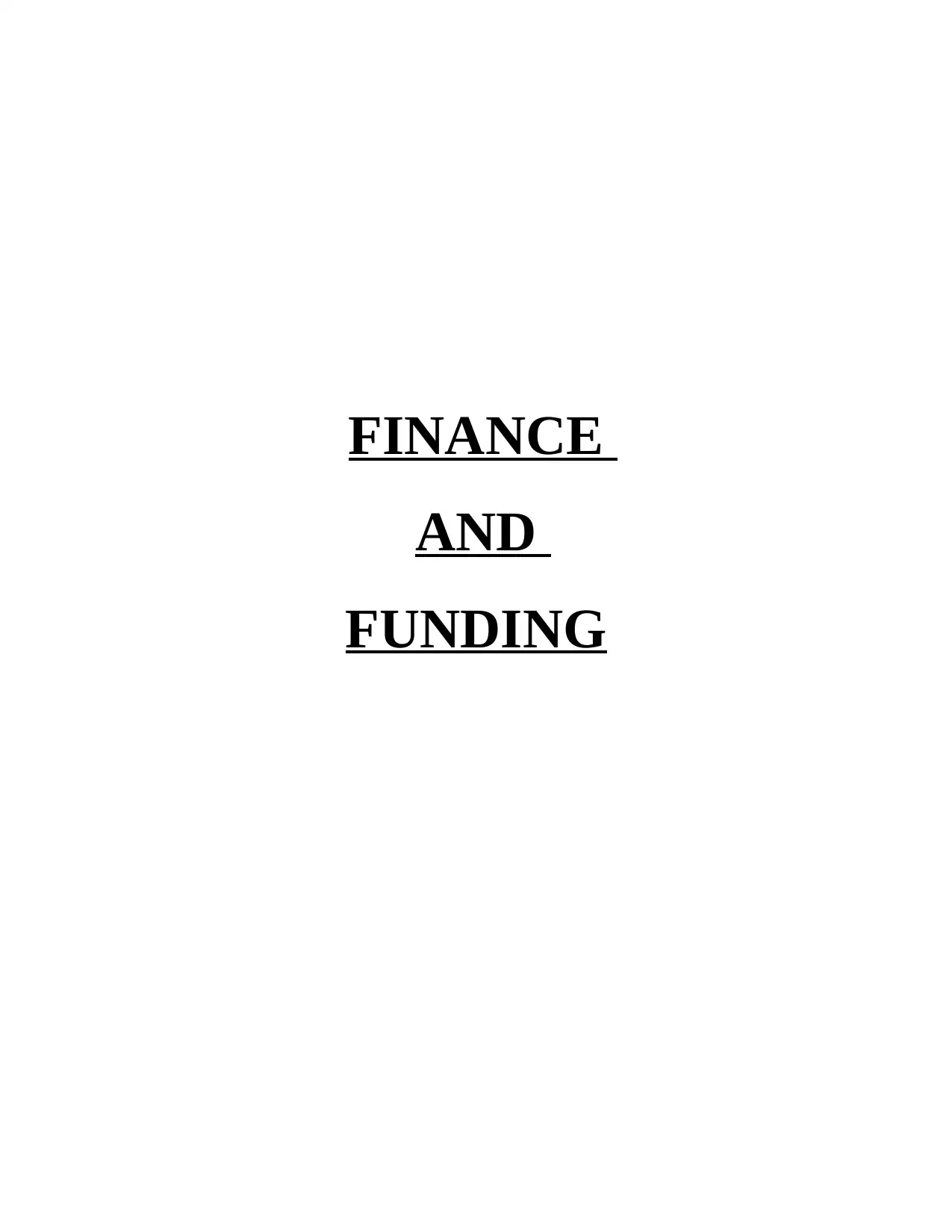
FINANCE
AND
FUNDING
AND
FUNDING
Paraphrase This Document
Need a fresh take? Get an instant paraphrase of this document with our AI Paraphraser
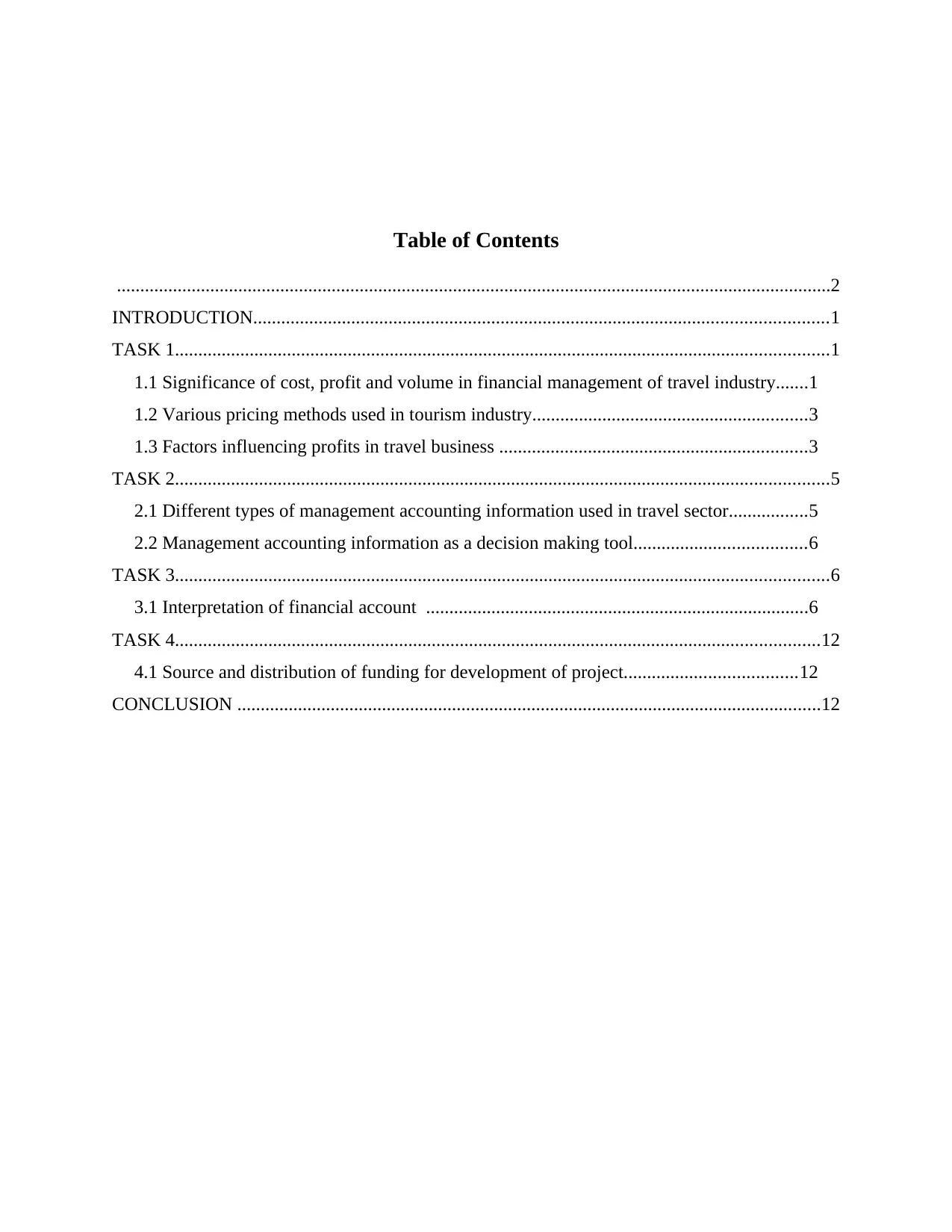
Table of Contents
.........................................................................................................................................................2
INTRODUCTION...........................................................................................................................1
TASK 1............................................................................................................................................1
1.1 Significance of cost, profit and volume in financial management of travel industry.......1
1.2 Various pricing methods used in tourism industry...........................................................3
1.3 Factors influencing profits in travel business ..................................................................3
TASK 2............................................................................................................................................5
2.1 Different types of management accounting information used in travel sector.................5
2.2 Management accounting information as a decision making tool.....................................6
TASK 3............................................................................................................................................6
3.1 Interpretation of financial account ..................................................................................6
TASK 4..........................................................................................................................................12
4.1 Source and distribution of funding for development of project.....................................12
CONCLUSION .............................................................................................................................12
.........................................................................................................................................................2
INTRODUCTION...........................................................................................................................1
TASK 1............................................................................................................................................1
1.1 Significance of cost, profit and volume in financial management of travel industry.......1
1.2 Various pricing methods used in tourism industry...........................................................3
1.3 Factors influencing profits in travel business ..................................................................3
TASK 2............................................................................................................................................5
2.1 Different types of management accounting information used in travel sector.................5
2.2 Management accounting information as a decision making tool.....................................6
TASK 3............................................................................................................................................6
3.1 Interpretation of financial account ..................................................................................6
TASK 4..........................................................................................................................................12
4.1 Source and distribution of funding for development of project.....................................12
CONCLUSION .............................................................................................................................12

⊘ This is a preview!⊘
Do you want full access?
Subscribe today to unlock all pages.

Trusted by 1+ million students worldwide
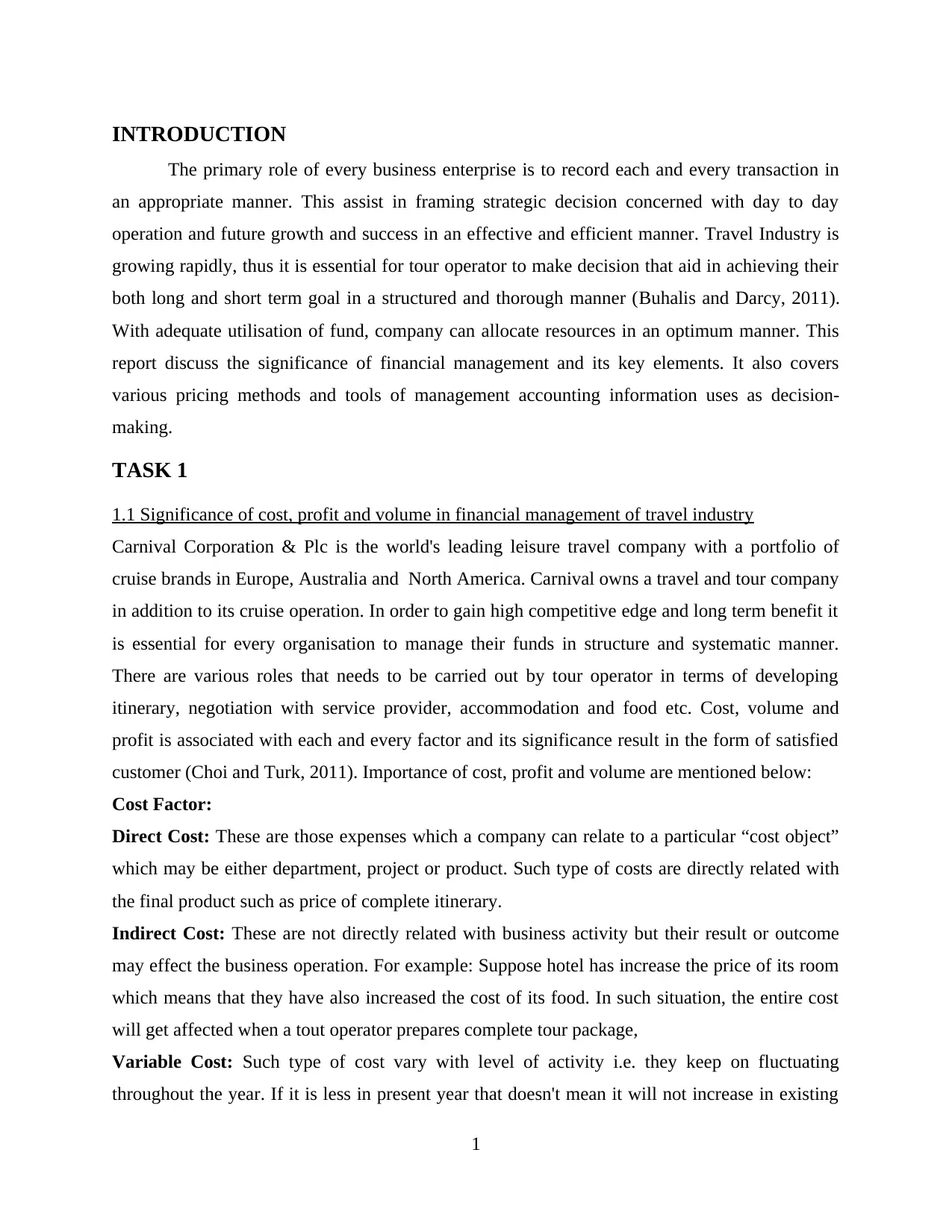
INTRODUCTION
The primary role of every business enterprise is to record each and every transaction in
an appropriate manner. This assist in framing strategic decision concerned with day to day
operation and future growth and success in an effective and efficient manner. Travel Industry is
growing rapidly, thus it is essential for tour operator to make decision that aid in achieving their
both long and short term goal in a structured and thorough manner (Buhalis and Darcy, 2011).
With adequate utilisation of fund, company can allocate resources in an optimum manner. This
report discuss the significance of financial management and its key elements. It also covers
various pricing methods and tools of management accounting information uses as decision-
making.
TASK 1
1.1 Significance of cost, profit and volume in financial management of travel industry
Carnival Corporation & Plc is the world's leading leisure travel company with a portfolio of
cruise brands in Europe, Australia and North America. Carnival owns a travel and tour company
in addition to its cruise operation. In order to gain high competitive edge and long term benefit it
is essential for every organisation to manage their funds in structure and systematic manner.
There are various roles that needs to be carried out by tour operator in terms of developing
itinerary, negotiation with service provider, accommodation and food etc. Cost, volume and
profit is associated with each and every factor and its significance result in the form of satisfied
customer (Choi and Turk, 2011). Importance of cost, profit and volume are mentioned below:
Cost Factor:
Direct Cost: These are those expenses which a company can relate to a particular “cost object”
which may be either department, project or product. Such type of costs are directly related with
the final product such as price of complete itinerary.
Indirect Cost: These are not directly related with business activity but their result or outcome
may effect the business operation. For example: Suppose hotel has increase the price of its room
which means that they have also increased the cost of its food. In such situation, the entire cost
will get affected when a tout operator prepares complete tour package,
Variable Cost: Such type of cost vary with level of activity i.e. they keep on fluctuating
throughout the year. If it is less in present year that doesn't mean it will not increase in existing
1
The primary role of every business enterprise is to record each and every transaction in
an appropriate manner. This assist in framing strategic decision concerned with day to day
operation and future growth and success in an effective and efficient manner. Travel Industry is
growing rapidly, thus it is essential for tour operator to make decision that aid in achieving their
both long and short term goal in a structured and thorough manner (Buhalis and Darcy, 2011).
With adequate utilisation of fund, company can allocate resources in an optimum manner. This
report discuss the significance of financial management and its key elements. It also covers
various pricing methods and tools of management accounting information uses as decision-
making.
TASK 1
1.1 Significance of cost, profit and volume in financial management of travel industry
Carnival Corporation & Plc is the world's leading leisure travel company with a portfolio of
cruise brands in Europe, Australia and North America. Carnival owns a travel and tour company
in addition to its cruise operation. In order to gain high competitive edge and long term benefit it
is essential for every organisation to manage their funds in structure and systematic manner.
There are various roles that needs to be carried out by tour operator in terms of developing
itinerary, negotiation with service provider, accommodation and food etc. Cost, volume and
profit is associated with each and every factor and its significance result in the form of satisfied
customer (Choi and Turk, 2011). Importance of cost, profit and volume are mentioned below:
Cost Factor:
Direct Cost: These are those expenses which a company can relate to a particular “cost object”
which may be either department, project or product. Such type of costs are directly related with
the final product such as price of complete itinerary.
Indirect Cost: These are not directly related with business activity but their result or outcome
may effect the business operation. For example: Suppose hotel has increase the price of its room
which means that they have also increased the cost of its food. In such situation, the entire cost
will get affected when a tout operator prepares complete tour package,
Variable Cost: Such type of cost vary with level of activity i.e. they keep on fluctuating
throughout the year. If it is less in present year that doesn't mean it will not increase in existing
1
Paraphrase This Document
Need a fresh take? Get an instant paraphrase of this document with our AI Paraphraser
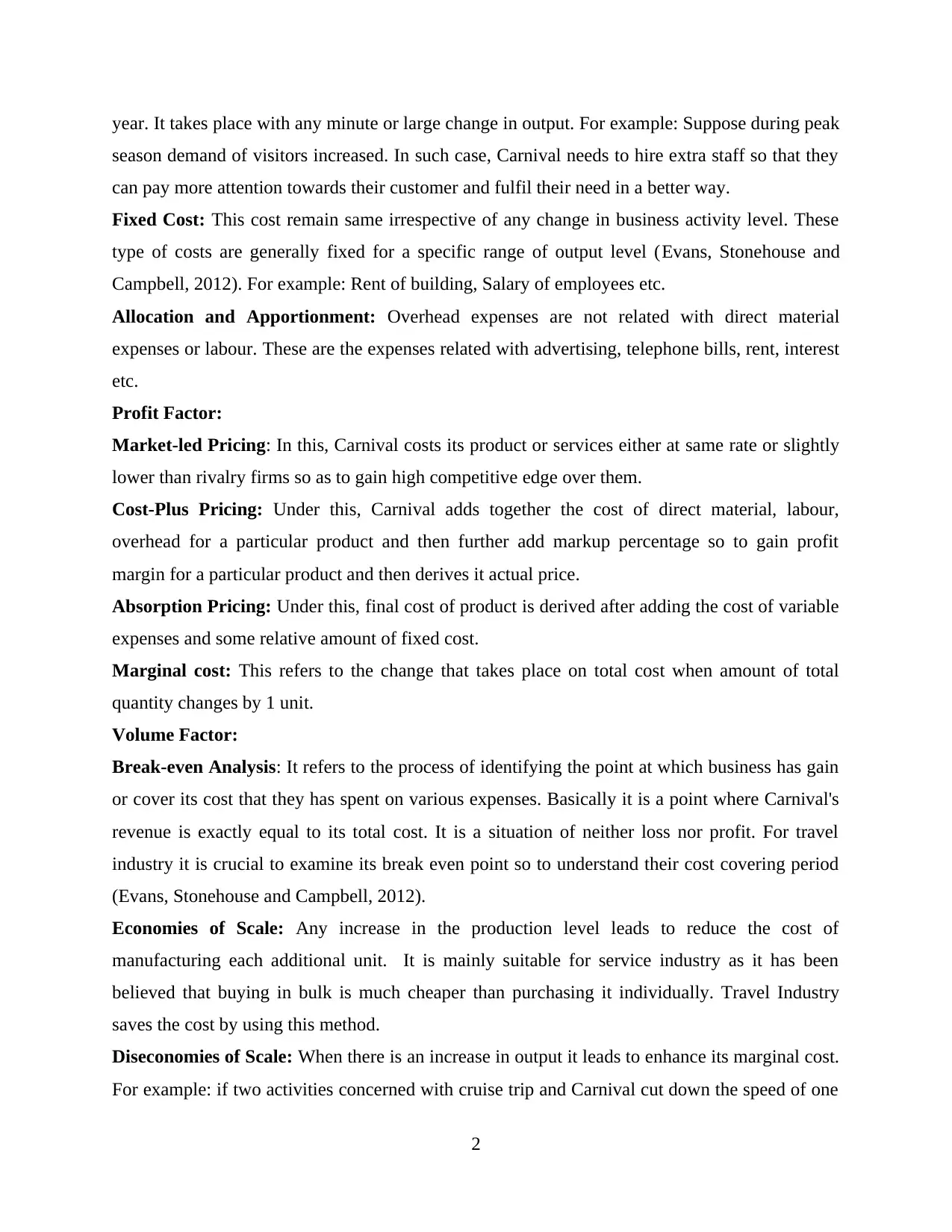
year. It takes place with any minute or large change in output. For example: Suppose during peak
season demand of visitors increased. In such case, Carnival needs to hire extra staff so that they
can pay more attention towards their customer and fulfil their need in a better way.
Fixed Cost: This cost remain same irrespective of any change in business activity level. These
type of costs are generally fixed for a specific range of output level (Evans, Stonehouse and
Campbell, 2012). For example: Rent of building, Salary of employees etc.
Allocation and Apportionment: Overhead expenses are not related with direct material
expenses or labour. These are the expenses related with advertising, telephone bills, rent, interest
etc.
Profit Factor:
Market-led Pricing: In this, Carnival costs its product or services either at same rate or slightly
lower than rivalry firms so as to gain high competitive edge over them.
Cost-Plus Pricing: Under this, Carnival adds together the cost of direct material, labour,
overhead for a particular product and then further add markup percentage so to gain profit
margin for a particular product and then derives it actual price.
Absorption Pricing: Under this, final cost of product is derived after adding the cost of variable
expenses and some relative amount of fixed cost.
Marginal cost: This refers to the change that takes place on total cost when amount of total
quantity changes by 1 unit.
Volume Factor:
Break-even Analysis: It refers to the process of identifying the point at which business has gain
or cover its cost that they has spent on various expenses. Basically it is a point where Carnival's
revenue is exactly equal to its total cost. It is a situation of neither loss nor profit. For travel
industry it is crucial to examine its break even point so to understand their cost covering period
(Evans, Stonehouse and Campbell, 2012).
Economies of Scale: Any increase in the production level leads to reduce the cost of
manufacturing each additional unit. It is mainly suitable for service industry as it has been
believed that buying in bulk is much cheaper than purchasing it individually. Travel Industry
saves the cost by using this method.
Diseconomies of Scale: When there is an increase in output it leads to enhance its marginal cost.
For example: if two activities concerned with cruise trip and Carnival cut down the speed of one
2
season demand of visitors increased. In such case, Carnival needs to hire extra staff so that they
can pay more attention towards their customer and fulfil their need in a better way.
Fixed Cost: This cost remain same irrespective of any change in business activity level. These
type of costs are generally fixed for a specific range of output level (Evans, Stonehouse and
Campbell, 2012). For example: Rent of building, Salary of employees etc.
Allocation and Apportionment: Overhead expenses are not related with direct material
expenses or labour. These are the expenses related with advertising, telephone bills, rent, interest
etc.
Profit Factor:
Market-led Pricing: In this, Carnival costs its product or services either at same rate or slightly
lower than rivalry firms so as to gain high competitive edge over them.
Cost-Plus Pricing: Under this, Carnival adds together the cost of direct material, labour,
overhead for a particular product and then further add markup percentage so to gain profit
margin for a particular product and then derives it actual price.
Absorption Pricing: Under this, final cost of product is derived after adding the cost of variable
expenses and some relative amount of fixed cost.
Marginal cost: This refers to the change that takes place on total cost when amount of total
quantity changes by 1 unit.
Volume Factor:
Break-even Analysis: It refers to the process of identifying the point at which business has gain
or cover its cost that they has spent on various expenses. Basically it is a point where Carnival's
revenue is exactly equal to its total cost. It is a situation of neither loss nor profit. For travel
industry it is crucial to examine its break even point so to understand their cost covering period
(Evans, Stonehouse and Campbell, 2012).
Economies of Scale: Any increase in the production level leads to reduce the cost of
manufacturing each additional unit. It is mainly suitable for service industry as it has been
believed that buying in bulk is much cheaper than purchasing it individually. Travel Industry
saves the cost by using this method.
Diseconomies of Scale: When there is an increase in output it leads to enhance its marginal cost.
For example: if two activities concerned with cruise trip and Carnival cut down the speed of one
2
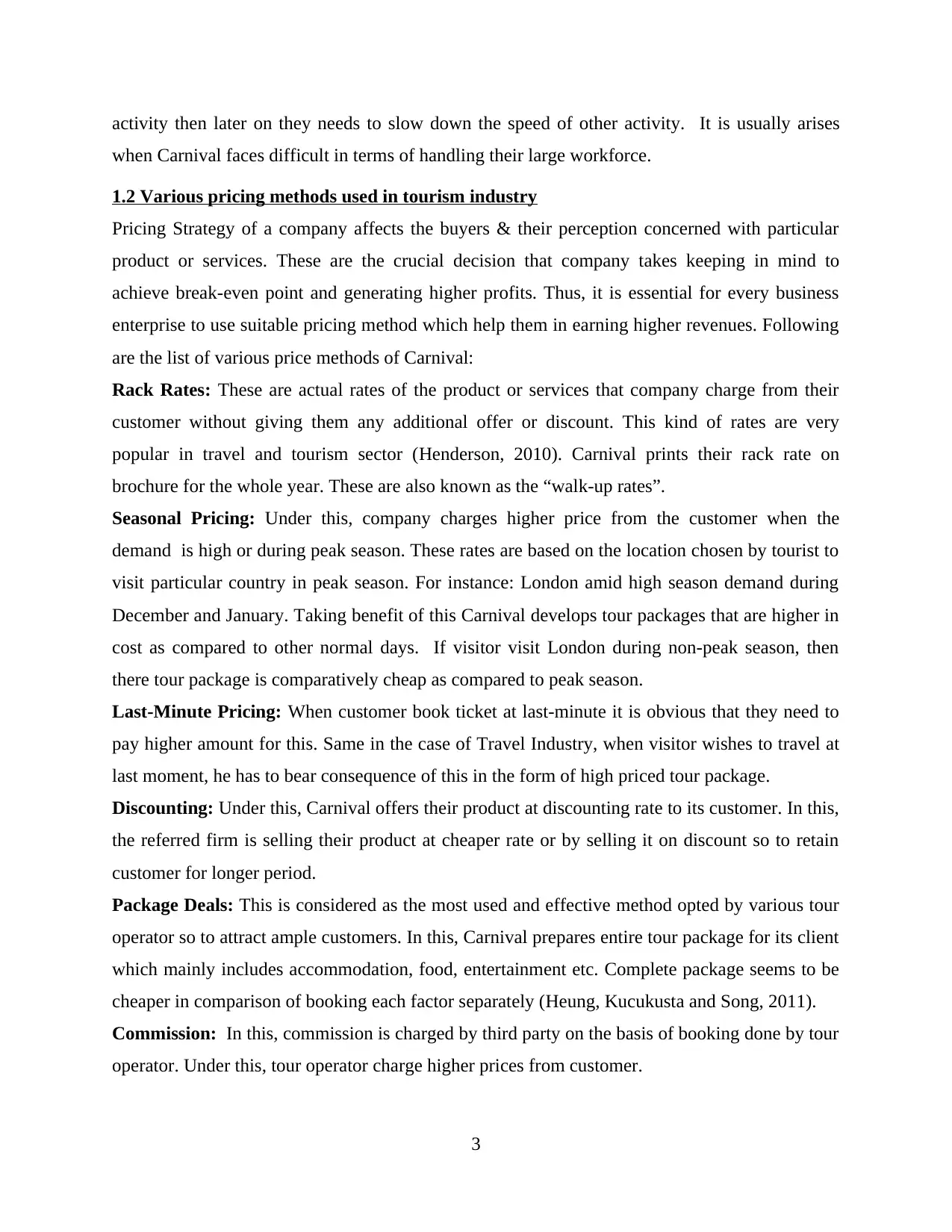
activity then later on they needs to slow down the speed of other activity. It is usually arises
when Carnival faces difficult in terms of handling their large workforce.
1.2 Various pricing methods used in tourism industry
Pricing Strategy of a company affects the buyers & their perception concerned with particular
product or services. These are the crucial decision that company takes keeping in mind to
achieve break-even point and generating higher profits. Thus, it is essential for every business
enterprise to use suitable pricing method which help them in earning higher revenues. Following
are the list of various price methods of Carnival:
Rack Rates: These are actual rates of the product or services that company charge from their
customer without giving them any additional offer or discount. This kind of rates are very
popular in travel and tourism sector (Henderson, 2010). Carnival prints their rack rate on
brochure for the whole year. These are also known as the “walk-up rates”.
Seasonal Pricing: Under this, company charges higher price from the customer when the
demand is high or during peak season. These rates are based on the location chosen by tourist to
visit particular country in peak season. For instance: London amid high season demand during
December and January. Taking benefit of this Carnival develops tour packages that are higher in
cost as compared to other normal days. If visitor visit London during non-peak season, then
there tour package is comparatively cheap as compared to peak season.
Last-Minute Pricing: When customer book ticket at last-minute it is obvious that they need to
pay higher amount for this. Same in the case of Travel Industry, when visitor wishes to travel at
last moment, he has to bear consequence of this in the form of high priced tour package.
Discounting: Under this, Carnival offers their product at discounting rate to its customer. In this,
the referred firm is selling their product at cheaper rate or by selling it on discount so to retain
customer for longer period.
Package Deals: This is considered as the most used and effective method opted by various tour
operator so to attract ample customers. In this, Carnival prepares entire tour package for its client
which mainly includes accommodation, food, entertainment etc. Complete package seems to be
cheaper in comparison of booking each factor separately (Heung, Kucukusta and Song, 2011).
Commission: In this, commission is charged by third party on the basis of booking done by tour
operator. Under this, tour operator charge higher prices from customer.
3
when Carnival faces difficult in terms of handling their large workforce.
1.2 Various pricing methods used in tourism industry
Pricing Strategy of a company affects the buyers & their perception concerned with particular
product or services. These are the crucial decision that company takes keeping in mind to
achieve break-even point and generating higher profits. Thus, it is essential for every business
enterprise to use suitable pricing method which help them in earning higher revenues. Following
are the list of various price methods of Carnival:
Rack Rates: These are actual rates of the product or services that company charge from their
customer without giving them any additional offer or discount. This kind of rates are very
popular in travel and tourism sector (Henderson, 2010). Carnival prints their rack rate on
brochure for the whole year. These are also known as the “walk-up rates”.
Seasonal Pricing: Under this, company charges higher price from the customer when the
demand is high or during peak season. These rates are based on the location chosen by tourist to
visit particular country in peak season. For instance: London amid high season demand during
December and January. Taking benefit of this Carnival develops tour packages that are higher in
cost as compared to other normal days. If visitor visit London during non-peak season, then
there tour package is comparatively cheap as compared to peak season.
Last-Minute Pricing: When customer book ticket at last-minute it is obvious that they need to
pay higher amount for this. Same in the case of Travel Industry, when visitor wishes to travel at
last moment, he has to bear consequence of this in the form of high priced tour package.
Discounting: Under this, Carnival offers their product at discounting rate to its customer. In this,
the referred firm is selling their product at cheaper rate or by selling it on discount so to retain
customer for longer period.
Package Deals: This is considered as the most used and effective method opted by various tour
operator so to attract ample customers. In this, Carnival prepares entire tour package for its client
which mainly includes accommodation, food, entertainment etc. Complete package seems to be
cheaper in comparison of booking each factor separately (Heung, Kucukusta and Song, 2011).
Commission: In this, commission is charged by third party on the basis of booking done by tour
operator. Under this, tour operator charge higher prices from customer.
3
⊘ This is a preview!⊘
Do you want full access?
Subscribe today to unlock all pages.

Trusted by 1+ million students worldwide
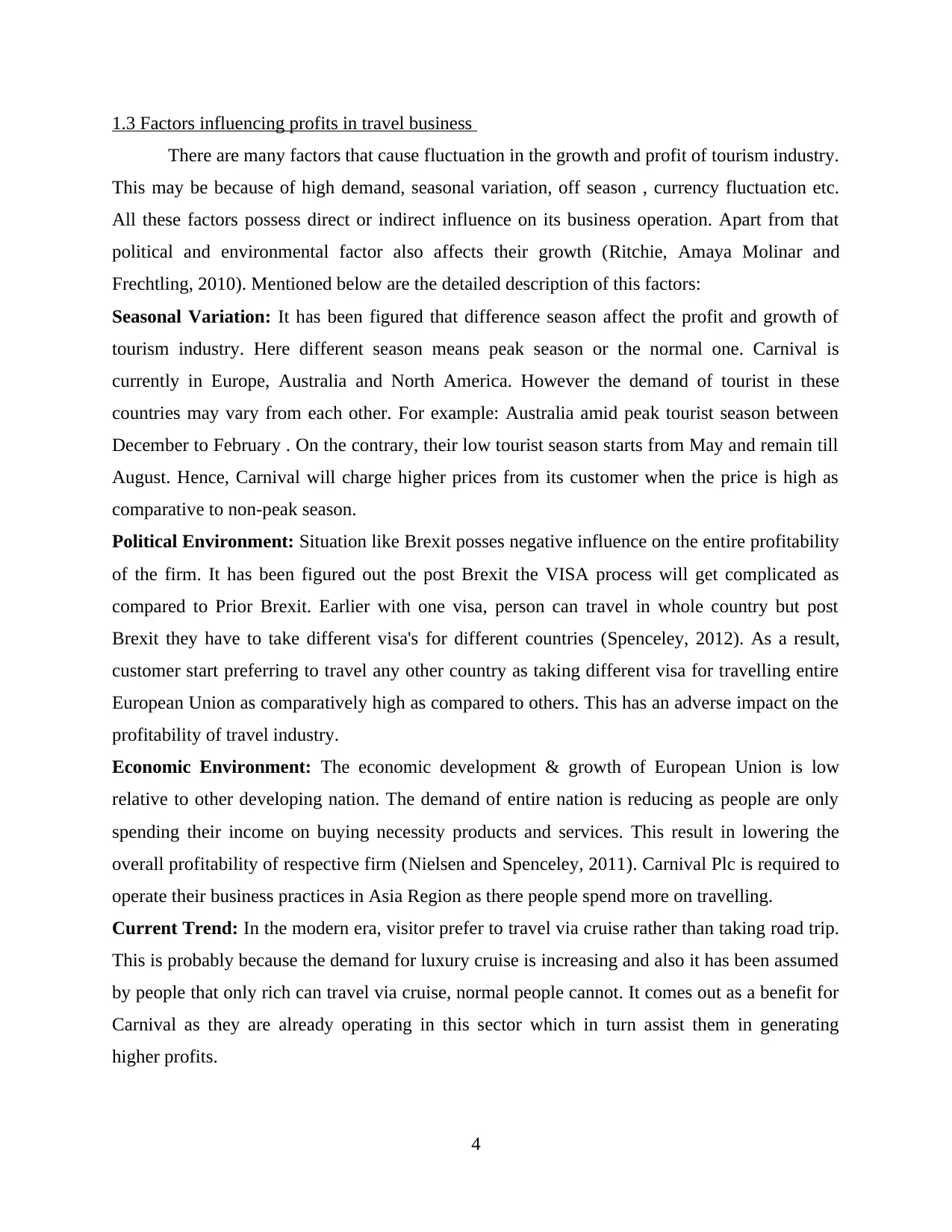
1.3 Factors influencing profits in travel business
There are many factors that cause fluctuation in the growth and profit of tourism industry.
This may be because of high demand, seasonal variation, off season , currency fluctuation etc.
All these factors possess direct or indirect influence on its business operation. Apart from that
political and environmental factor also affects their growth (Ritchie, Amaya Molinar and
Frechtling, 2010). Mentioned below are the detailed description of this factors:
Seasonal Variation: It has been figured that difference season affect the profit and growth of
tourism industry. Here different season means peak season or the normal one. Carnival is
currently in Europe, Australia and North America. However the demand of tourist in these
countries may vary from each other. For example: Australia amid peak tourist season between
December to February . On the contrary, their low tourist season starts from May and remain till
August. Hence, Carnival will charge higher prices from its customer when the price is high as
comparative to non-peak season.
Political Environment: Situation like Brexit posses negative influence on the entire profitability
of the firm. It has been figured out the post Brexit the VISA process will get complicated as
compared to Prior Brexit. Earlier with one visa, person can travel in whole country but post
Brexit they have to take different visa's for different countries (Spenceley, 2012). As a result,
customer start preferring to travel any other country as taking different visa for travelling entire
European Union as comparatively high as compared to others. This has an adverse impact on the
profitability of travel industry.
Economic Environment: The economic development & growth of European Union is low
relative to other developing nation. The demand of entire nation is reducing as people are only
spending their income on buying necessity products and services. This result in lowering the
overall profitability of respective firm (Nielsen and Spenceley, 2011). Carnival Plc is required to
operate their business practices in Asia Region as there people spend more on travelling.
Current Trend: In the modern era, visitor prefer to travel via cruise rather than taking road trip.
This is probably because the demand for luxury cruise is increasing and also it has been assumed
by people that only rich can travel via cruise, normal people cannot. It comes out as a benefit for
Carnival as they are already operating in this sector which in turn assist them in generating
higher profits.
4
There are many factors that cause fluctuation in the growth and profit of tourism industry.
This may be because of high demand, seasonal variation, off season , currency fluctuation etc.
All these factors possess direct or indirect influence on its business operation. Apart from that
political and environmental factor also affects their growth (Ritchie, Amaya Molinar and
Frechtling, 2010). Mentioned below are the detailed description of this factors:
Seasonal Variation: It has been figured that difference season affect the profit and growth of
tourism industry. Here different season means peak season or the normal one. Carnival is
currently in Europe, Australia and North America. However the demand of tourist in these
countries may vary from each other. For example: Australia amid peak tourist season between
December to February . On the contrary, their low tourist season starts from May and remain till
August. Hence, Carnival will charge higher prices from its customer when the price is high as
comparative to non-peak season.
Political Environment: Situation like Brexit posses negative influence on the entire profitability
of the firm. It has been figured out the post Brexit the VISA process will get complicated as
compared to Prior Brexit. Earlier with one visa, person can travel in whole country but post
Brexit they have to take different visa's for different countries (Spenceley, 2012). As a result,
customer start preferring to travel any other country as taking different visa for travelling entire
European Union as comparatively high as compared to others. This has an adverse impact on the
profitability of travel industry.
Economic Environment: The economic development & growth of European Union is low
relative to other developing nation. The demand of entire nation is reducing as people are only
spending their income on buying necessity products and services. This result in lowering the
overall profitability of respective firm (Nielsen and Spenceley, 2011). Carnival Plc is required to
operate their business practices in Asia Region as there people spend more on travelling.
Current Trend: In the modern era, visitor prefer to travel via cruise rather than taking road trip.
This is probably because the demand for luxury cruise is increasing and also it has been assumed
by people that only rich can travel via cruise, normal people cannot. It comes out as a benefit for
Carnival as they are already operating in this sector which in turn assist them in generating
higher profits.
4
Paraphrase This Document
Need a fresh take? Get an instant paraphrase of this document with our AI Paraphraser
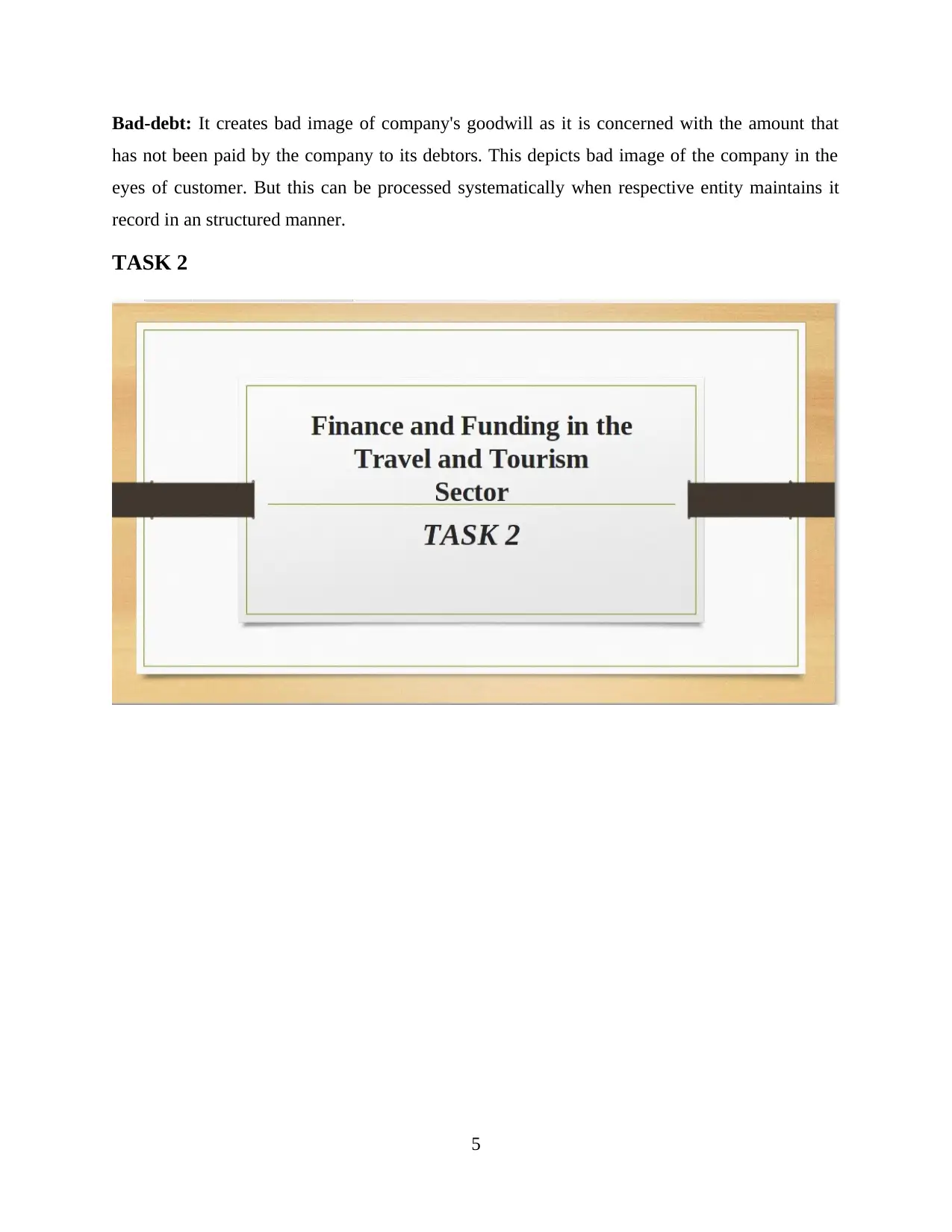
Bad-debt: It creates bad image of company's goodwill as it is concerned with the amount that
has not been paid by the company to its debtors. This depicts bad image of the company in the
eyes of customer. But this can be processed systematically when respective entity maintains it
record in an structured manner.
TASK 2
5
has not been paid by the company to its debtors. This depicts bad image of the company in the
eyes of customer. But this can be processed systematically when respective entity maintains it
record in an structured manner.
TASK 2
5
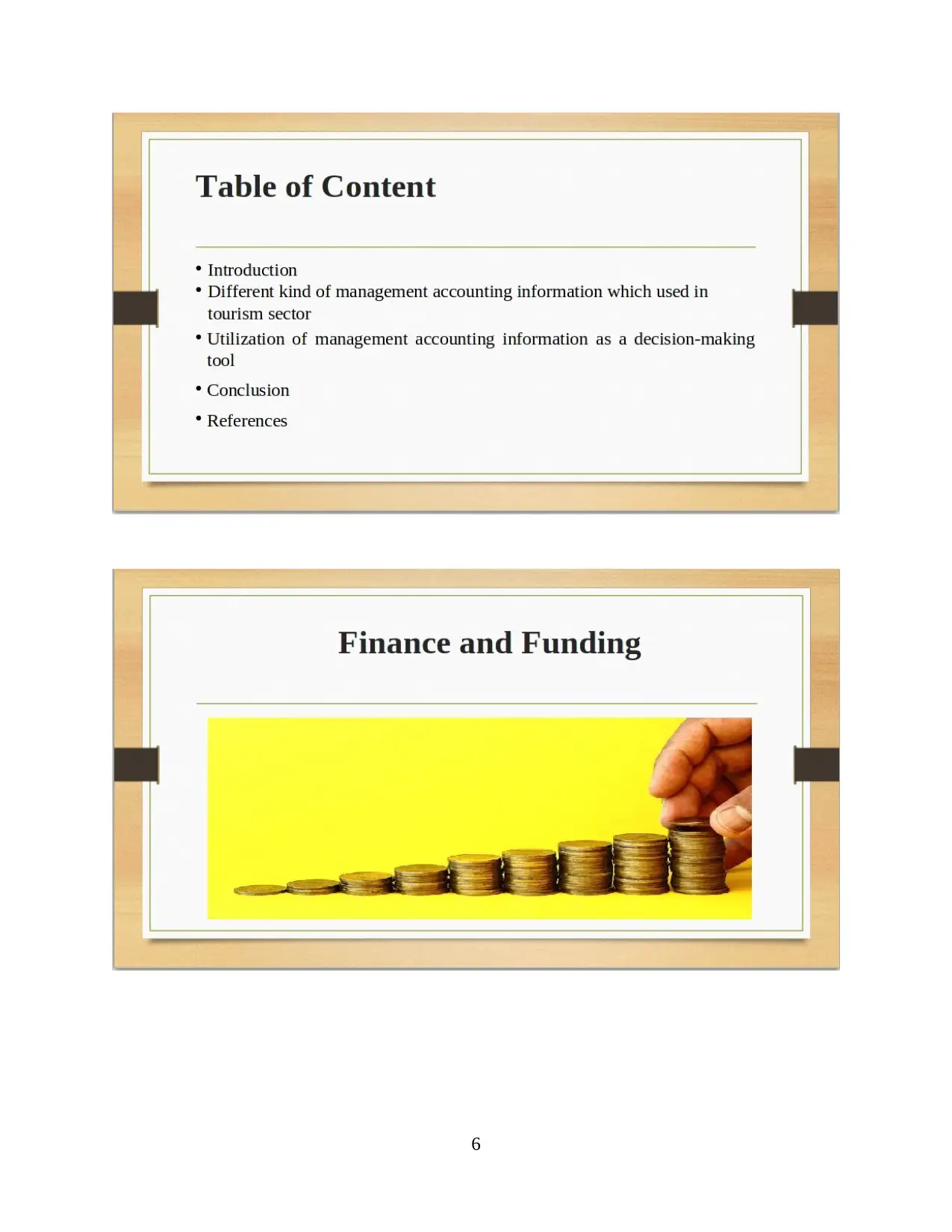
6
⊘ This is a preview!⊘
Do you want full access?
Subscribe today to unlock all pages.

Trusted by 1+ million students worldwide
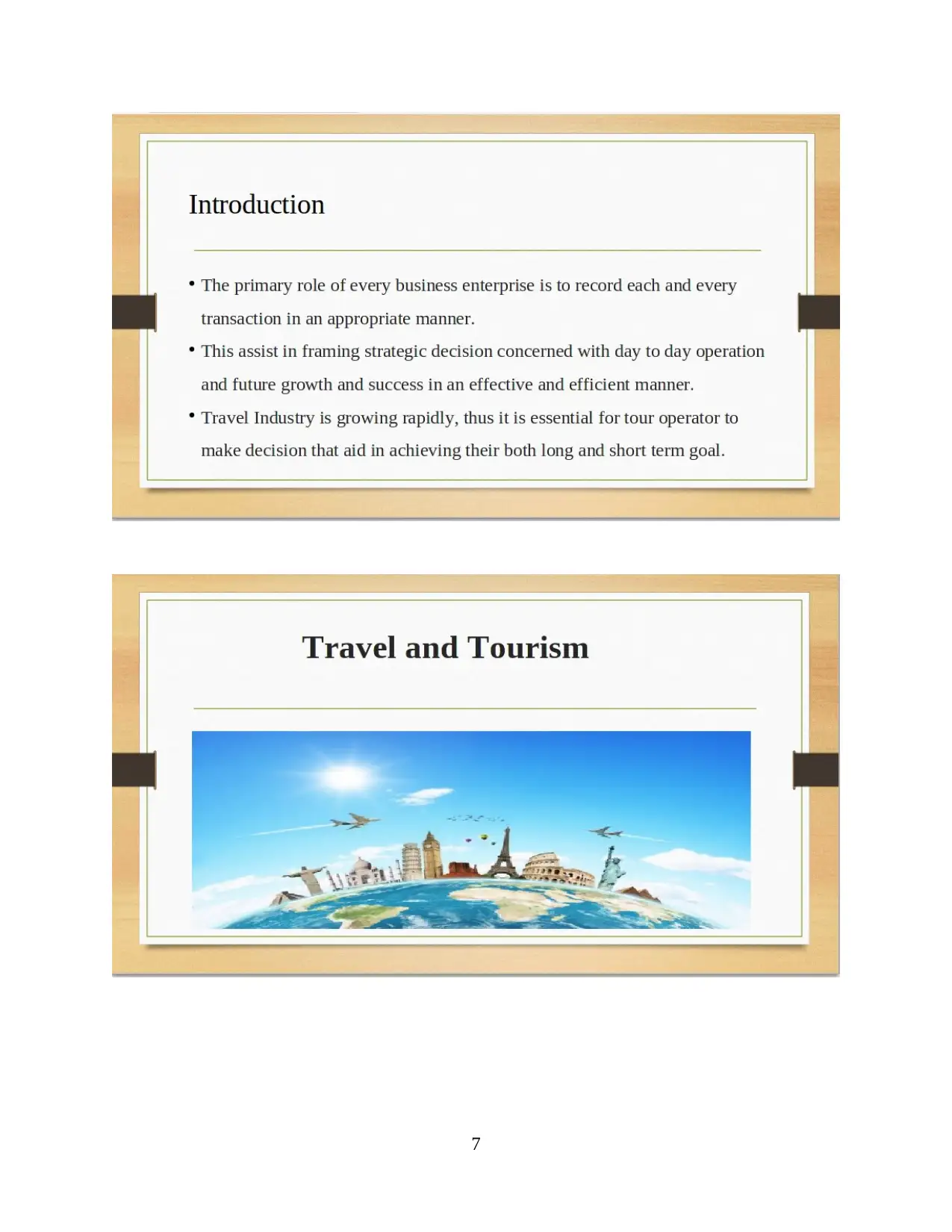
7
Paraphrase This Document
Need a fresh take? Get an instant paraphrase of this document with our AI Paraphraser
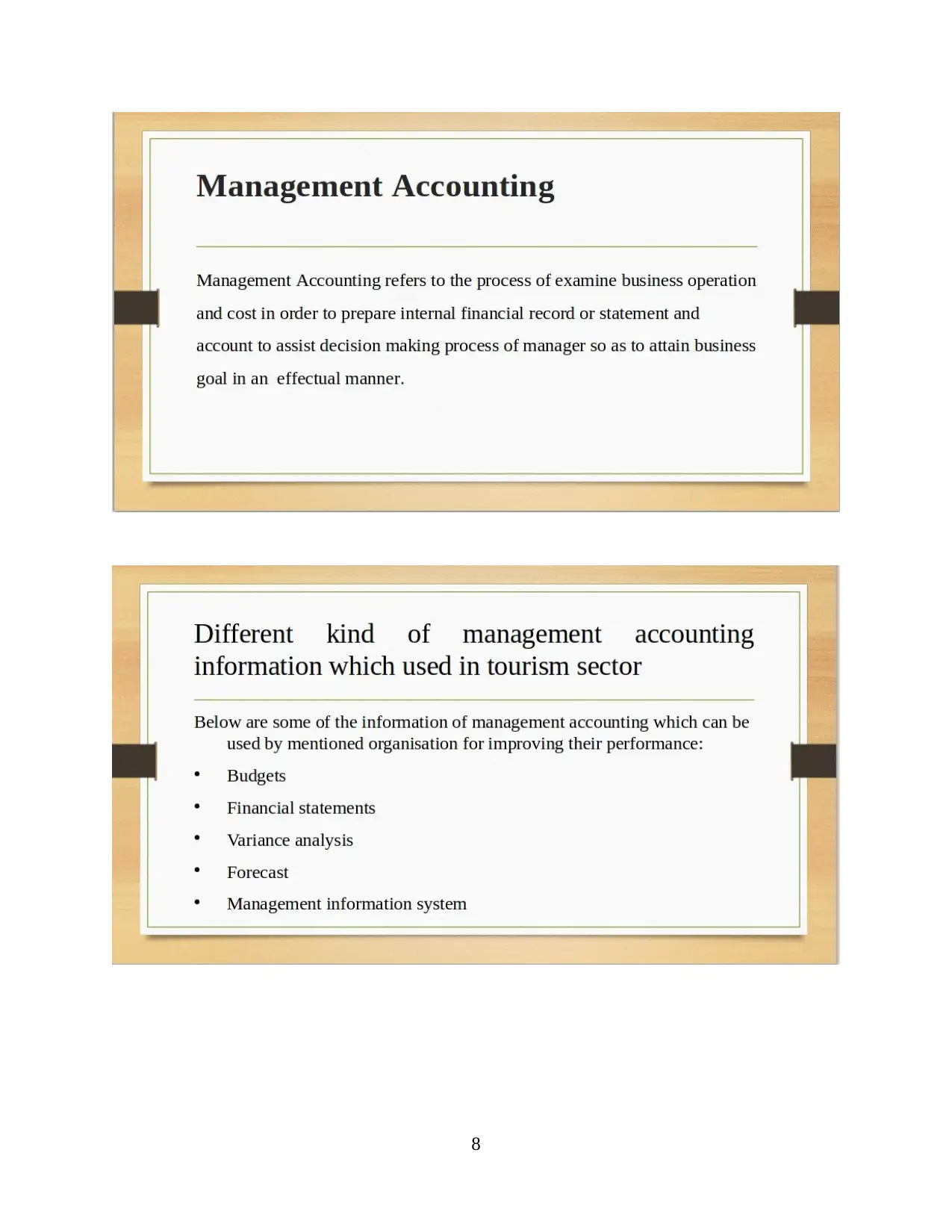
8
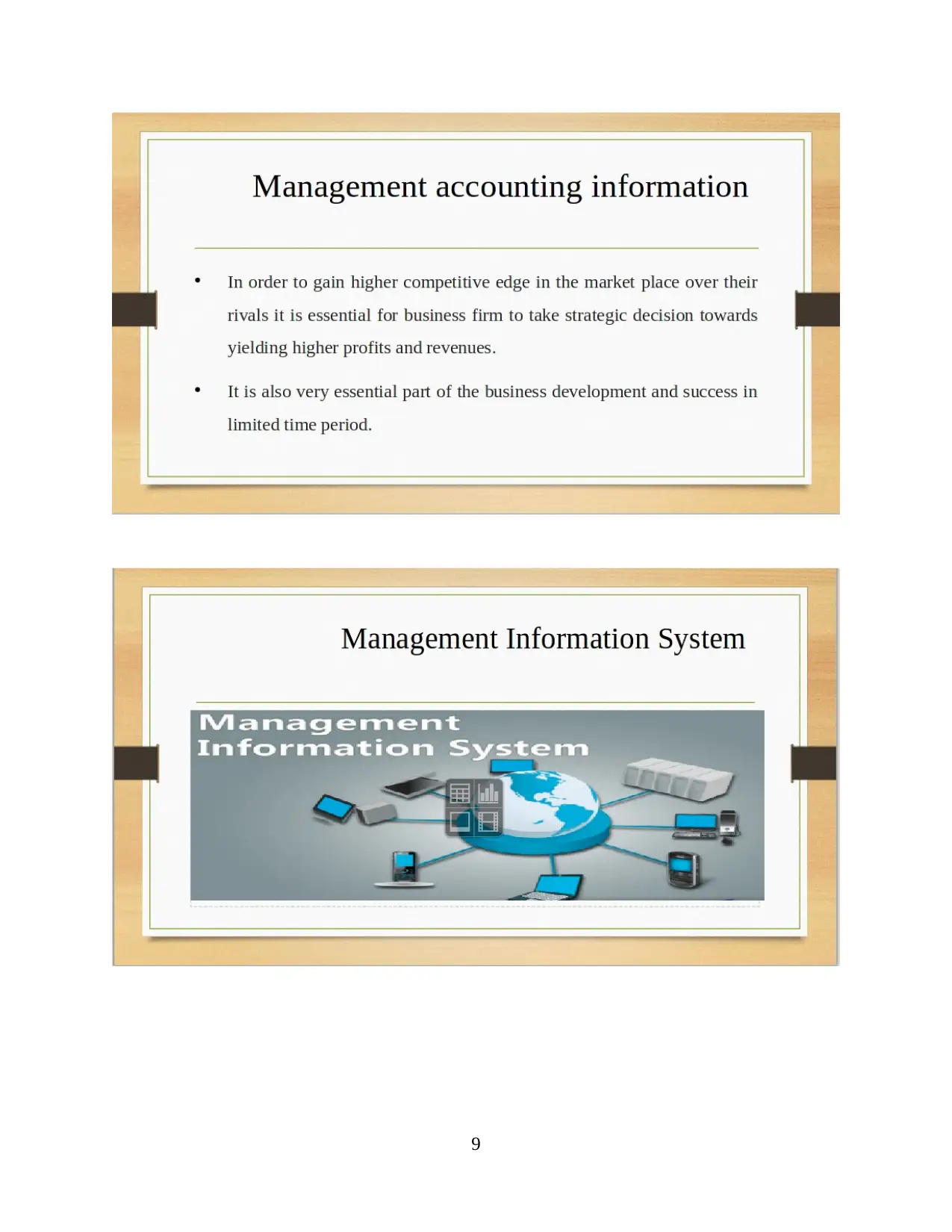
9
⊘ This is a preview!⊘
Do you want full access?
Subscribe today to unlock all pages.

Trusted by 1+ million students worldwide
1 out of 24
Related Documents
Your All-in-One AI-Powered Toolkit for Academic Success.
+13062052269
info@desklib.com
Available 24*7 on WhatsApp / Email
![[object Object]](/_next/static/media/star-bottom.7253800d.svg)
Unlock your academic potential
Copyright © 2020–2025 A2Z Services. All Rights Reserved. Developed and managed by ZUCOL.





